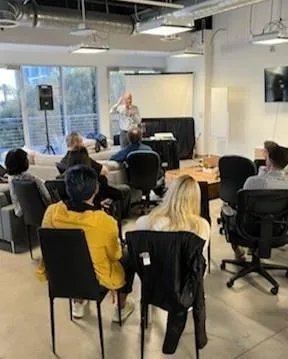
Ravé Strategy Studio


Up-Skill Leaders In Your Organization And Win!
Higher Customer Satisfaction
Better Operational Efficiency
More Product and Work Quality
Less Rework
Higher Productivity
Impact Leaders Blog

Making Career Decisions with your Family in Mind
Folks who succeed in life seem to be those who find that elusive work-life balance while exuding a sense of purpose
Kip was your typical geek, heading IT architecture for a reputable company. He had a beautiful family, a good job, and an easy smile. Something was eating at him, though. Over drinks one evening he told me that his wife observed a change in his enjoyment of life over the last few years. He summed it up by saying he felt his life lacked purpose.
Pressing him to explain, he said managing networks for a company didn't feel like making a contribution to the world. Sure, he said, his wife and kids were blessings, but something was missing at work. He wanted to make a difference.
As a technologist, he said cybersecurity professionals were making more of what he called "an impact on the world." Finishing his second drink, he said, "I went into IT because I liked tinkering with computers and networks. But I love the idea of keeping them up and running, no matter what happens."
Cybersecurity, he decided, was where it was at. He asked me how to retool as a cybersecurity pro. He was visibly surprised when I said he already was one.
The best leaders in cybersecurity today are not the ones with white-hack hacking skills -- though Kip had a few of those, which I saw one day when he demonstrated an SYN attack, illuminating a weakness in his network's architecture. The best leaders in cybersecurity are those who know how to lead a team to become an efficient machine, always improving, always audit-ready, always incident-ready.
On the other hand, the worst leaders are those who rely on technologies and faster-and-faster patching times and incident response times to run security. I showed him that running security like a fire department is the surest path to high-cost failures and high-profile hacks.
Leadership based on core values and following best practices of continual improvement, continuous learning & coaching, engaging employees, and measurement & recognition -- this is the stuff of a well-run security program.
I showed him the NIST framework for cybersecurity and its companion standard, the NIST Baldrige performance excellence framework. These two together, I told him, are the most comprehensive roadmap to true cybersecurity leadership.
Six months later, Kip was heading cybersecurity at a new company. Six months after that he was promoted to CISO. Kip is on his way to becoming a recognized leader in cybersecurity by running security like a business.
Steve Hunt helps professionals like you to excel on the path to growth and improvement.
Improve leaders in three key areas:

Self-Leadership
Leadership starts from within. Leaders are self-aware and have an honest view of themselves and recognize their impact and influence on others. They lead authentically with personal values, purpose, and vision. Self-leadership means being responsible for results, choices, actions, inactions, behaviors, thoughts, communication, and attitude. It also means demonstrating resilience and consistent performance under pressure.
Training themes include:
Developing Self-Awareness
Developing E.Q. for Sustainable High Performance
Exploring Biases
Being a Self-Starter
Responsibility
Time-Management
Showing up as a leader
Integrity
Inspiring Trust
Power of Networking
Handling Uncertainty and Complexity
Consequences of Power
Handling Stress
Professional Presence
Building Personal Resilience
Owning Your Own Development
Innovative Thinking
Team Leadership
Leaders are effective when they can scale their impact. Effective leaders have the knowledge, skills, and attitudes that engage, motivate, inspire, develop, and empower other people. They demonstrate communication skills for inclusive team engagement, strengthening everyone's ability to adapt with agility, especially in times of stress, uncertainty, "overwhelm."

Training themes include:
Motivating High Performance
Developing & Leading High Performing Teams
Diverse, Inclusive Leadership
Understanding Personality Styles
Being a Team Player
Building Team Resilience
Giving and receiving feedback
Leading Virtual Teams
Effective Storytelling
Crisis Communication
Getting to yes
Influencing Others
Organizational Leadership
Effective leaders communicate a strategy and shared vision that motivates and inspires the people they work with. They actively seek diverse perspectives by collaborating with others both outside and within the organization to drive business results. They balance innovation with smart risk-taking and leverage the strengths of their organization.

Training themes include:
Leading Organizational Culture & Alignment
Outside-In Strategy Development
Strategy Execution During Times of Uncertainty
Driving Organizational Transformation
Enterprise Thinking
Cross-functional Collaboration
Creating the Agile Organization
Driving Innovation
Working through obstacles
Creating Results
Data Driven Decision-Making
M&A Integration
